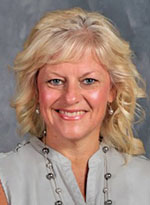Joyful Witness / Kimberly Pohovey
Looking through lens of empathy enables us to find common grey area
 I’ll never forget the look on my mother’s face as she entered my hospital room and saw me laughing along with a friend of mine. It was a look of such unease. I flinched, then introduced her to my good friend Steven. They exchanged pleasantries as Steven made his exit.
I’ll never forget the look on my mother’s face as she entered my hospital room and saw me laughing along with a friend of mine. It was a look of such unease. I flinched, then introduced her to my good friend Steven. They exchanged pleasantries as Steven made his exit.
It was 1988, and I was a college student. Steven was kind enough to come visit while I was in the hospital recovering from an infection. Steven and I had become good friends while working together on the college newspaper staff. He was gregarious, smart, kind and had a terrific laugh. Oh, and Steven was black.
When Steven left my hospital room, my Mom inquired about our relationship. I let her know we were just good friends, but the undercurrent was that my Mom would not approve if Steven was my boyfriend. In my Mom’s eyes, that would be inappropriate. I remember being so angry with her for her obvious prejudice. As a 20-year old white student, racism was not a part of my life.
I have retold that story a few times over the years, and I have to admit my tone has changed. One thing I have come to understand with maturity is that the world is not black and white. Unfortunately, the world is still black and white, but there’s a whole lot of grey intertwined. That is to say, there is no one way of looking at the world, events or people. It takes empathy and understanding to blend the colors.
As I grappled with that incident over the years, I have to admit that I have tried to look at it with different lenses. At first, I was horrified that my friend might have picked up on my mother’s unease. Never having to deal with prejudice myself, I was aghast to think of additional times when Steven may have dealt with similar situations, or far worse. Later in life, I tried to understand my mother’s response from her perspective. She was a product of her upbringing, times and experience. She grew up in a suburb of Cincinnati that was all white. And in her era, mixed couples were not prevalent. I am certainly not vindicating her, simply stating that she thought what she did based on her environment and what she was taught. I think she feared what she did not know or understand.
Fast forward to my middle 20s. I was held up at gunpoint by two young men. The police thought it might have been some sort of gang initiation. Thankfully, I wasn’t physically hurt, but I did have psychological scars. And for the first time in my life, I grappled with whether I myself was prejudiced. The two young men who held me up and forced me into a car to drive around the mall to the back of the building, where it was dark and isolated, were black. For months, I had nightmares and was scared to be anywhere alone. To my own embarrassment, I was fearful of being in any situation with young black men—in parking lots, walking on city streets, leaving stores. This, I realized, was racial injustice. In time, what I came to understand is that it was rational for me to be afraid, given my experience. What wasn’t right was for me to generalize my fear. Two specific young men accosted me. Their act was criminal. It didn’t matter if they were black, white or purple. I had no justification for projecting my fear upon an entire race. My fear was related to the act of violence, not the color of the skin of the perpetrators.
In turning to prayer, I tried to empathize with these young men. What must their lives be like to propel them to secure a gun and commit a crime?
I have no answers for the racial challenges we face as a society. But I do believe empathy is needed on all sides. Empathy is the act of placing yourself in another’s shoes and attempting to understand their perspective. Empathy is that grey area that connects us to one another.
(Kimberly Pohovey is a member of St. Jude Parish in Indianapolis. She is the director of mission advancement for Archdiocesan Education Initiatives.) †
 I’ll never forget the look on my mother’s face as she entered my hospital room and saw me laughing along with a friend of mine. It was a look of such unease. I flinched, then introduced her to my good friend Steven. They exchanged pleasantries as Steven made his exit.
I’ll never forget the look on my mother’s face as she entered my hospital room and saw me laughing along with a friend of mine. It was a look of such unease. I flinched, then introduced her to my good friend Steven. They exchanged pleasantries as Steven made his exit.